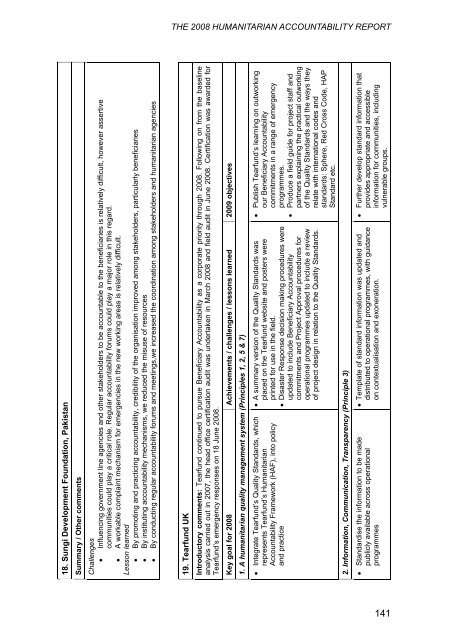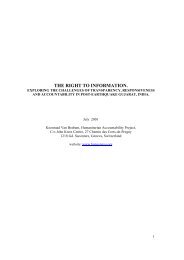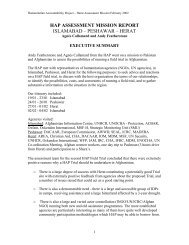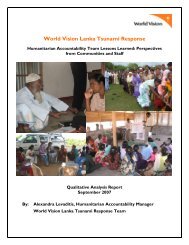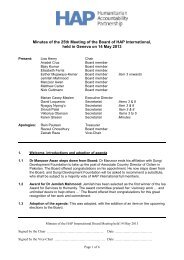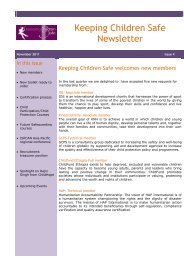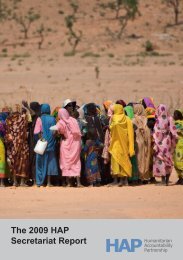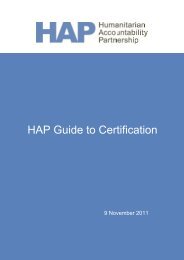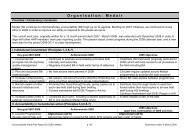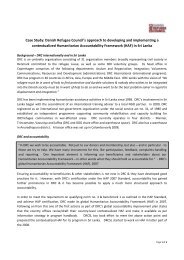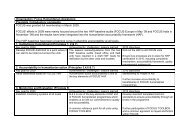Chapter Four - HAP International
Chapter Four - HAP International
Chapter Four - HAP International
You also want an ePaper? Increase the reach of your titles
YUMPU automatically turns print PDFs into web optimized ePapers that Google loves.
THE 2008 HUMANITARIAN ACCOUNTABILITY REPORT<br />
18. Sungi Development Foundation, Pakistan<br />
Summary / Other comments<br />
Challenges<br />
• Influencing government line agencies and other stakeholders to be accountable to the beneficiaries is relatively difficult, however assertive<br />
communities could play a critical role. Regular accountability forums could play a major role in this regard.<br />
• A workable complaint mechanism for emergencies in the new working areas is relatively difficult.<br />
Lesson learned<br />
• By promoting and practicing accountability, credibility of the organisation improved among stakeholders, particularly beneficiaries<br />
• By instituting accountability mechanisms, we reduced the misuse of resources<br />
• By conducting regular accountability forums and meetings,we increased the coordination among stakeholders and humanitarian agencies<br />
19. Tearfund UK<br />
Introductory comments: Tearfund continued to pursue Beneficiary Accountability as a corporate priority through 2008. Following on from the baseline<br />
analysis carried out in 2007, the head office certification audit was undertaken in March 2008 and field audit in June 2008. Certification was awarded for<br />
Tearfund’s emergency responses on 18 June 2008.<br />
Key goal for 2008 Achievements / challenges / lessons learned 2009 objectives<br />
1. A humanitarian quality management system (Principles 1, 2, 5 & 7)<br />
• Integrate Tearfund’s Quality Standards, which<br />
represents Tearfund’s Humanitarian<br />
Accountability Framework (HAF), into policy<br />
and practice<br />
• A summary version of the Quality Standards was<br />
placed on the Tearfund website and posters were<br />
printed for use in the field.<br />
• Disaster Response decision making procedures were<br />
updated to include Beneficiary Accountability<br />
commitments and Project Approval procedures for<br />
operational programmes updated to include a review<br />
of project design in relation to the Quality Standards.<br />
• Publish Tearfund’s learning on outworking<br />
our Beneficiary Accountability<br />
commitments in a range of emergency<br />
programmes.<br />
• Produce a field guide for project staff and<br />
partners explaining the practical outworking<br />
of the Quality Standards and the ways they<br />
relate with international codes and<br />
standards: Sphere, Red Cross Code, <strong>HAP</strong><br />
Standard etc.<br />
2. Information, Communication, Transparency (Principle 3)<br />
• Standardise the information to be made<br />
publicly available across operational<br />
programmes<br />
• Template of standard information was updated and<br />
distributed to operational programmes, with guidance<br />
on contextualisation and exoneration.<br />
• Further develop standard information that<br />
provides appropriate and accessible<br />
information for communities, including<br />
vulnerable groups.<br />
116<br />
141


